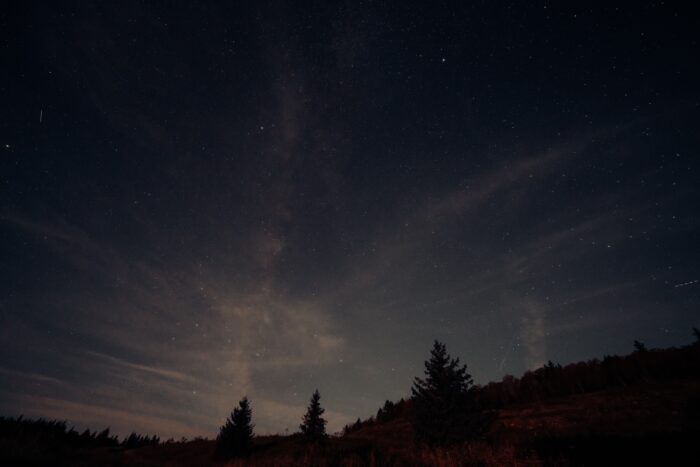Stargazing In Nature’s Mountain Playground Is Out Of This World
Far from the hustle and bustle of city lights, Pocahontas County, West Virginia, is a prime stargazing location. Nestled among the breathtaking Appalachian Mountains, our picturesque region offers celestial wonders that will leave you in awe. Whether you are an astronomy enthusiast or a casual viewer, Pocahontas County is the perfect place for a stargazing adventure.
Astronomy might seem a bit overwhelming at first glance, but it is all about taking small steps into the cosmic unknown. We’re here to show you that stargazing basics can be a piece of cake – no rocket science required! So, let’s kick back, relax under the twinkling night sky and unravel the mysteries together. Grab your telescope or simply use your eyes, because the universe is waiting to reveal its secrets, one constellation at a time.
Where To Go

A whole new world comes alive at night in Nature’s Mountain Playground. And there are several places to embrace the moonlight here, from remote mountain peaks and observation towers to vast national forests and wilderness areas.
In October 2021, Watoga State Park, Droop Mountain Battlefield State Park and Calvin Price State Forest received the first official International Dark Sky Place designation in the state. Experience a sight of the night sky that stretches for miles at Watoga State Park. View the twinkling reflection on the surface of Watoga Lake for a truly mesmerizing experience that will live up to the park’s name (which comes from the Cherokee word for “starry waters.”) After sundown, the sky at Droop Mountain Battlefield State Park transforms into a celestial canvas. Head to the park’s tower for an unrivaled stargazing experience. From this elevated vantage point, you’ll be treated to a spectacular perspective of the stars, planets and constellations that illuminate the night sky. Discover the extraordinary allure of Calvin Price State Forest, a nature lover’s paradise that extends its wonders beyond daylight. As darkness falls, find yourself surrounded by the serene beauty of nature, under a blanket of stars that seem to stretch endlessly into the cosmos. Additionally, the Highland Scenic Highway commands impressive views of the night sky from the surrounding mountains and deep valleys of the Allegheny Highlands and features 43 miles and four striking overlooks.
Take your stargazing to the next level and join us for a celestial event. Stop by the Green Bank Observatory (GBO), home to the world’s largest fully-steerable radio telescope — the Robert C. Byrd Green Bank Telescope — which stands 485 feet tall and weighs 17 million pounds. Visit the Green Bank Science Center to join a behind-the-scenes guided tour of the site (a self-guided walking tour is also available) and enjoy the interactive displays at the Catching the Wave Exhibit Hall. Every August, GBO has a Star Party where visitors can view the night sky through optical telescopes.
Many of our state parks organize full moon hikes, star walks, astronomy workshops and more. Visit our events calendar on our website for details.
What To Look For
On a clear night during a full moon, visitors can see stars for miles. Stargazers may also catch a glimpse of the Milky Way crest over the horizon at certain times of the year. Thanks to the Earth’s axial tilt, both the visible constellations and the state’s distinctive seasons evolve throughout the year. While some stellar patterns may come and go, a handful of constellations remain steadfast in the northern hemisphere year-round. Keep an eye out for the timeless Ursa Major (Big Dipper), Ursa Minor (Little Dipper), Draco, Cassiopeia and Cepheus, affectionately known as circumpolar constellations. These celestial wonders dance around the north celestial pole, gracefully circumventing the Earth’s horizon, and remain visible at any time of the year in West Virginia.
During the summer months, a plethora of captivating constellations are visible. Facing north, you’ll find the regal Cassiopeia, resembling a grand “W” in the night sky. Look eastward to spot the majestic Pegasus, the winged horse, galloping through the heavens. Turning your attention south, the adventurous Sagittarius the Archer draws its bow, while Scorpius, with its distinct curving tail, follows closely behind. The celestial wolf, Lupus, shares the stage with the balanced scales of Libra. As you shift your view westward, the clever Corvus perches alongside the graceful Virgo and the mighty Leo, the lion, with its bright heart, the star Regulus.
Visit EarthSky to find out what to look for when identifying certain constellations, and for a comprehensive and interactive star map, check out Sky & Telescope.
Where To Stay

There is no better way to experience the night sky than to camp under the stars. Camping in Pocahontas County not only offers a front-row seat to the celestial splendors but also immerses you in the sights and sounds of nature.
If you are looking for another top-of-the-world escape, the Thorny Mountain Fire Tower in Seneca State Forest is for you. The tower stands 65 feet above the forest floor and provides a 360-degree, unobstructed glimpse of the dark sky. The fire tower can be rented for overnight stays from May to October.
During the nights, let the stars be your guide. But when you are preparing for your getaway, use our free adventure guide!
